Gaining An R.A.F Pilots Brevet In WW II
DELIGHTED to see you back on frequency, Taphappy, and that you enjoyed this gripping account which ranks among the best on this thread, I think. Ron’s postwar career post is almost complete, then into our next project: an account written by a Special Operator of 101 Sqn. Best wishes, TH!
The following users liked this post:
Navigation (Long before the Magenta Line)
Letís hear it for the Navs.
Now, back in the day, we used to navigate by drawing lines with chevrons on them, on paper charts, (no really) - and it usually worked out OK.
So, as we have been immersed in Lancaster Operations in recent posts around here, I hope that the attendant photos will be of interest to this congregation.
My late Godfather, name of Leo Charles Bent, a Lancashire lad, became a Nav. in Lancs. (The aircraft not the county), in the last year of WW2.
He trained at the No. 41 Air School in S. Africa, and after the usual AFU & OTU sessions he joined Bomber Command Main Force with No. 44 (Rhodesia Squadron) on Lancasters. He flew 13 ops. in 9 weeks with them from Dunholme Lodge.
His first op. was to Caen, Normandy, on 12 June 1944, (just 6 days after D-Day).
After a course at NTU Warboys (Sept 1944) he became a Pathfinder Nav. on No. 83 Squadron P.F.F. ( Lancasters again), this time out of Coningsby. He did 17 ops. with them. His final raid, on 25 April 1945 was to the oil refinery at Tonsberg, Norway, (the last Heavy Bomber operation of the war in Europe, involving 107 Lancasters and 12 Mosquitoes. That was the finish of his tour (30 ops.) and VE Day came 2 weeks later.
After his passing (aged 91), he left me his log book and the chart that you see here. It shows all the devious tracks (feints) and turning points that they made, before homing in on the target. All his 30 ops. are here, numbered and dated.
I hope that you can enlarge the photos and that you can then appreciate this genuine relic of WW2 paper chart navigation.
Ian BB
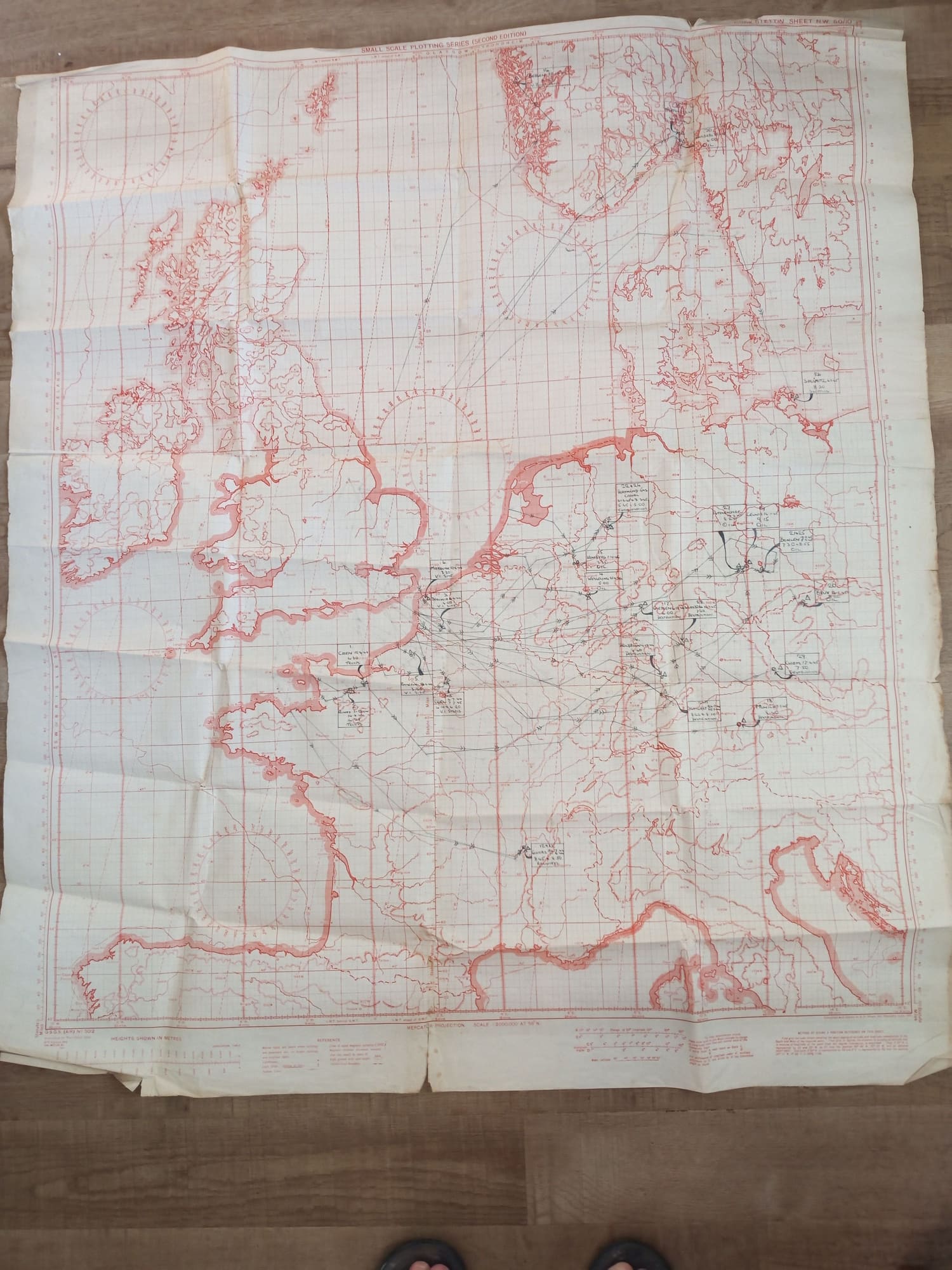
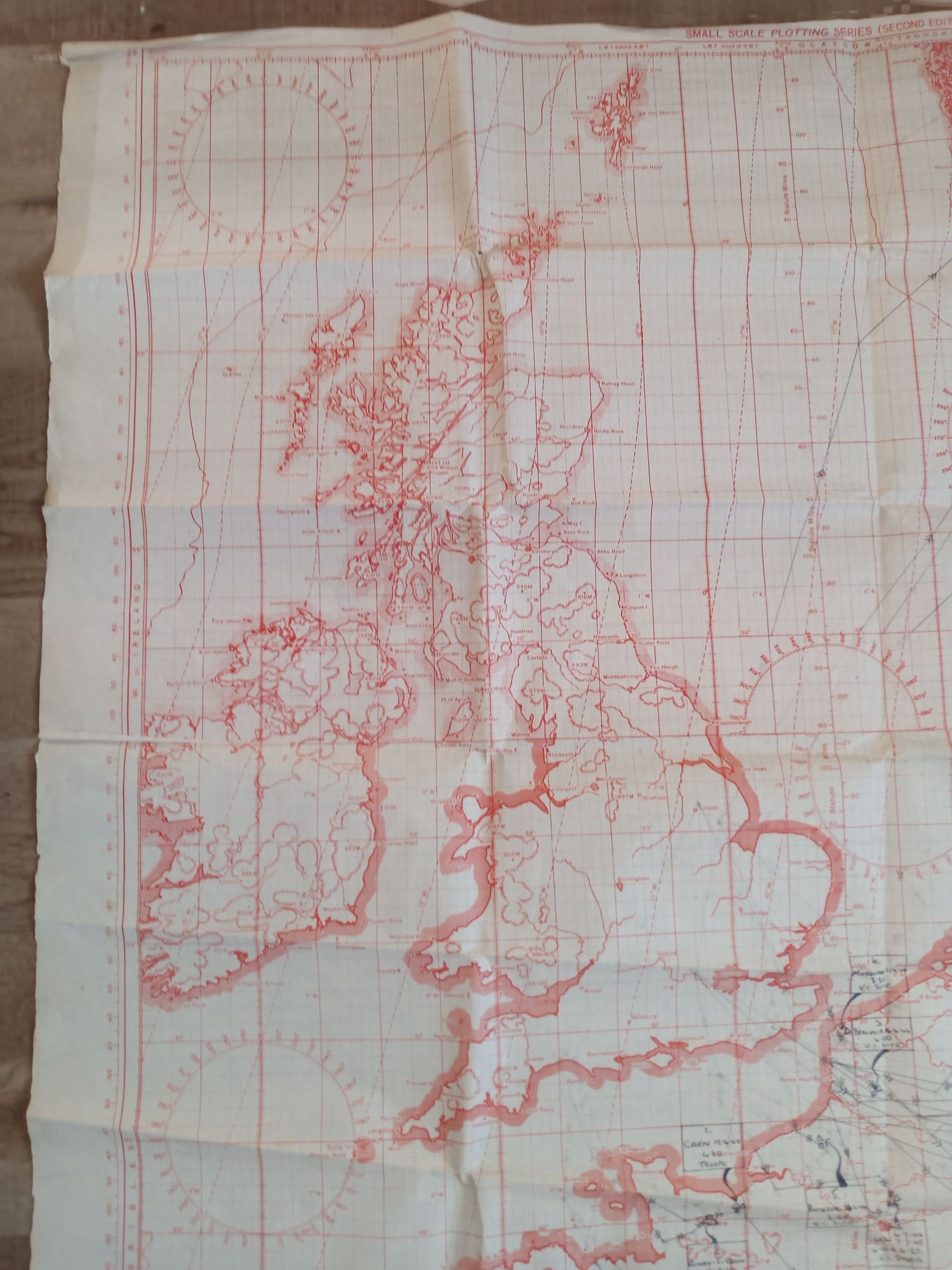

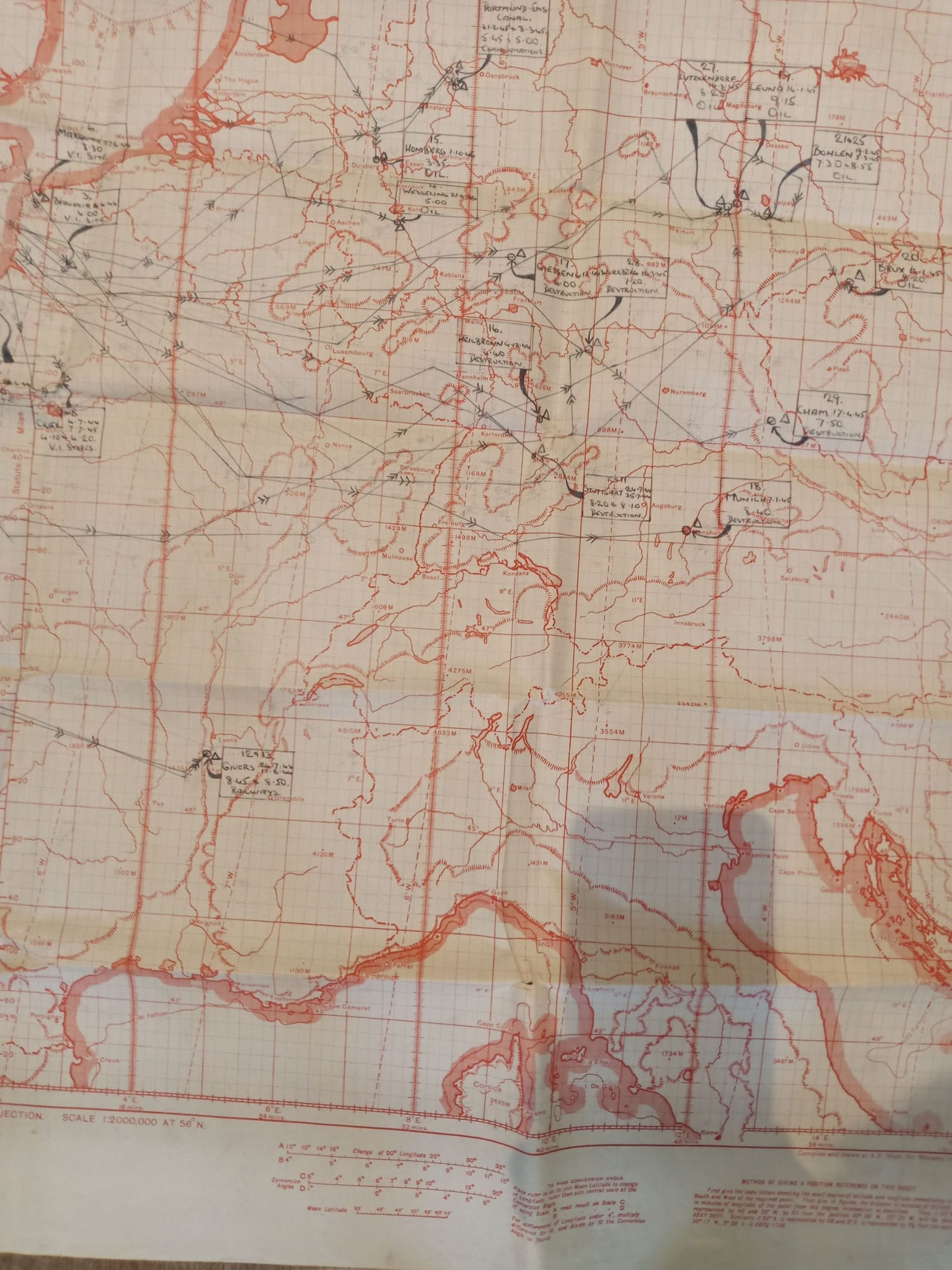
Now, back in the day, we used to navigate by drawing lines with chevrons on them, on paper charts, (no really) - and it usually worked out OK.
So, as we have been immersed in Lancaster Operations in recent posts around here, I hope that the attendant photos will be of interest to this congregation.
My late Godfather, name of Leo Charles Bent, a Lancashire lad, became a Nav. in Lancs. (The aircraft not the county), in the last year of WW2.
He trained at the No. 41 Air School in S. Africa, and after the usual AFU & OTU sessions he joined Bomber Command Main Force with No. 44 (Rhodesia Squadron) on Lancasters. He flew 13 ops. in 9 weeks with them from Dunholme Lodge.
His first op. was to Caen, Normandy, on 12 June 1944, (just 6 days after D-Day).
After a course at NTU Warboys (Sept 1944) he became a Pathfinder Nav. on No. 83 Squadron P.F.F. ( Lancasters again), this time out of Coningsby. He did 17 ops. with them. His final raid, on 25 April 1945 was to the oil refinery at Tonsberg, Norway, (the last Heavy Bomber operation of the war in Europe, involving 107 Lancasters and 12 Mosquitoes. That was the finish of his tour (30 ops.) and VE Day came 2 weeks later.
After his passing (aged 91), he left me his log book and the chart that you see here. It shows all the devious tracks (feints) and turning points that they made, before homing in on the target. All his 30 ops. are here, numbered and dated.
I hope that you can enlarge the photos and that you can then appreciate this genuine relic of WW2 paper chart navigation.
Ian BB




Missed One!
Finger trouble, I am 76 years old and all this computer stuff does not come naturally - and no child in the house to instruct me!
Here goes with the missing photo........
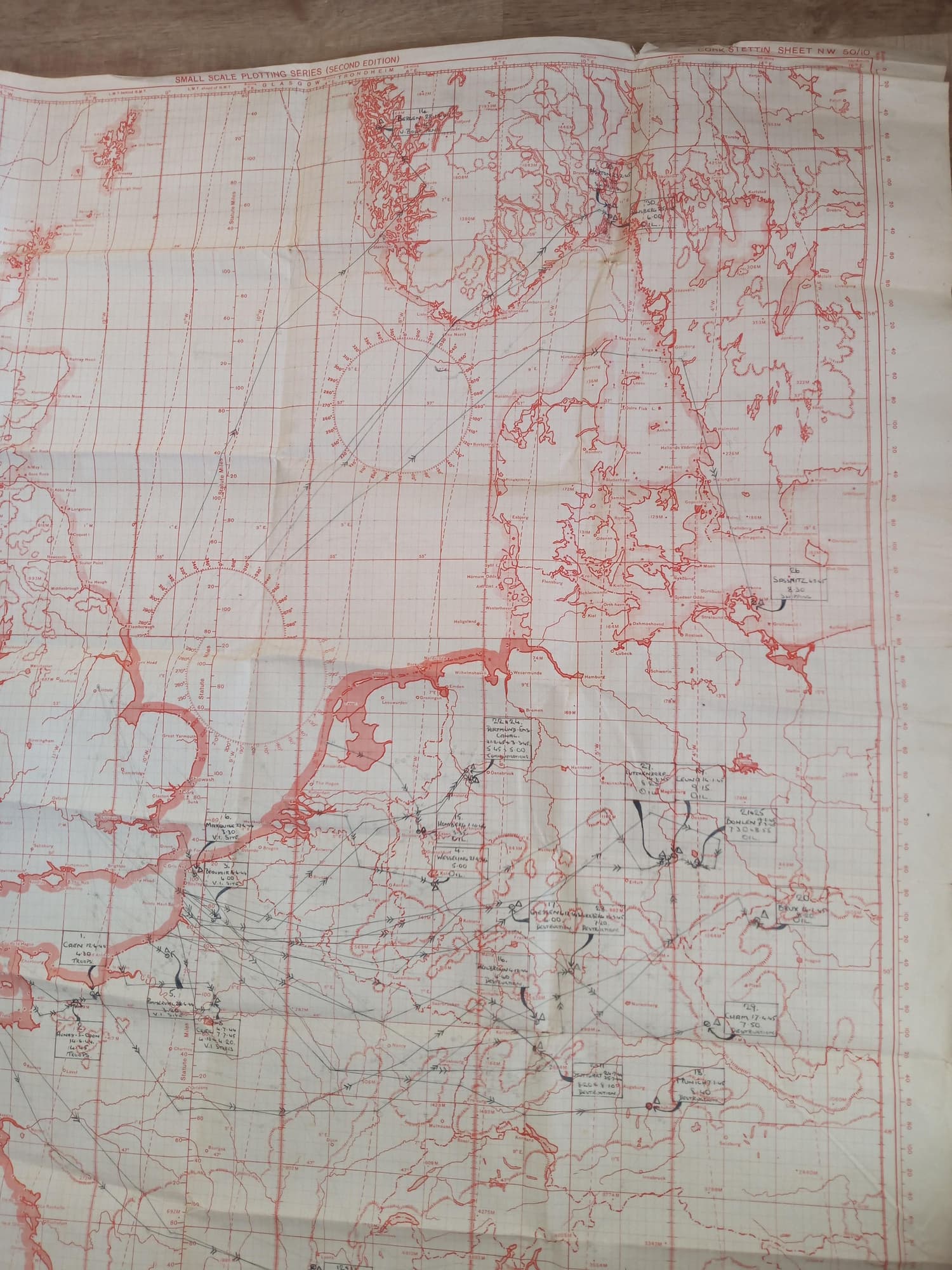
Here goes with the missing photo........

The following users liked this post:
Like some others, I had been neglecting this thread recently.
Geriaviator, thanks for posting that gripping story, I am passing on the link to other aviation, enthusiast friends.
Geriaviator, thanks for posting that gripping story, I am passing on the link to other aviation, enthusiast friends.
Wonderful memories of your godfather, Ian, and his meticulous plotting. I have wondered at the skills of the navs, from steering their way through the fiery skies of the Reich to pinpointing targets in the Mosquito's tiny cockpit as it streaked along at 300mph low level. India 42, the thread has been quiet since Danny's passing so it's nice to see it fired up again -- 34,000 views of Ron's story since its beginning on December 29. Just like old times!
Last edited by Geriaviator; 20th Jan 2024 at 16:50.
The following users liked this post:
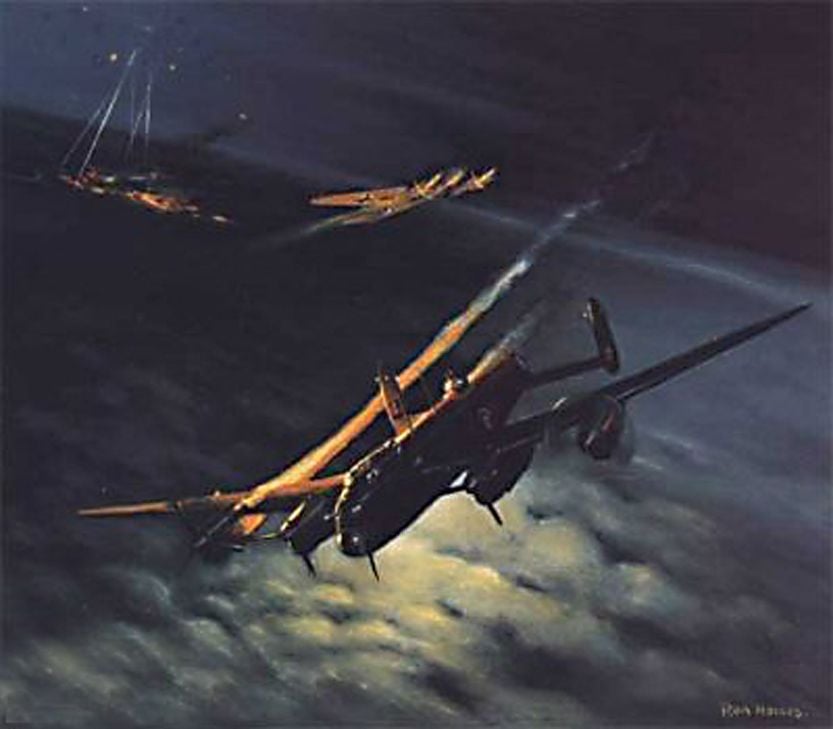
Ron Homes recreated those terrifying moments in his painting, A Night to Remember.
RONALD HOMES was born in London in 1922 and left school to study at Willesden College of Art. In 1940, at the age of 18, he enlisted in the Royal Air Force and after initial training went to Terrell, Texas, for flying training, where he gained his wings in May 1943.
On return to the UK for conversion training to Lancasters he joined 101 Special Operations squadron in May 1944, completing 32 operations. over Europe. After his bombing tour, for which he was awarded the DFC, he was promoted to Flt Lt and converted onto Dakotas, joining 238 Sqn to fly supply-dropping and casualty evacuation missions over Burma.
In June 1945 the squadron moved to Australia to provide transport support for the British Pacific Fleet around the South Pacific. After the Japanese surrender he joined 1315 Comms Flight and flew in Japan for the occupation forces.
On demob in 1946 Ron resumed his studies at the Central School of Arts and Crafts and spent the next 30 years as an industrial designer and manufacturer. He then taught painting at the Salisbury College of Art and with the Dorset and Wiltshire Adult Education classes. During the war he married Ione Baker, a union that would endure for more than 70 years. The couple had three children, four grandchildren and two great-grandchildren.
Throughout these years he was building his own reputation as a successful artist. He had many exhibitions in Shaftesbury where he lived, the West Country and Suffolk and he exhibited in London at the Royal Institute Mall Galleries and with the Guild of Aviation Artists. Ron kept in touch with his Lancaster crew for the rest of their lives, but did not fly again until a friend took him up in a light aircraft from Compton Abbas.
Ron Homes died on July 21, 2015 and was still painting up until his death at the age of 92. He is remembered in the Ron Homes Gallery in the Shaftesbury Arts Centre.
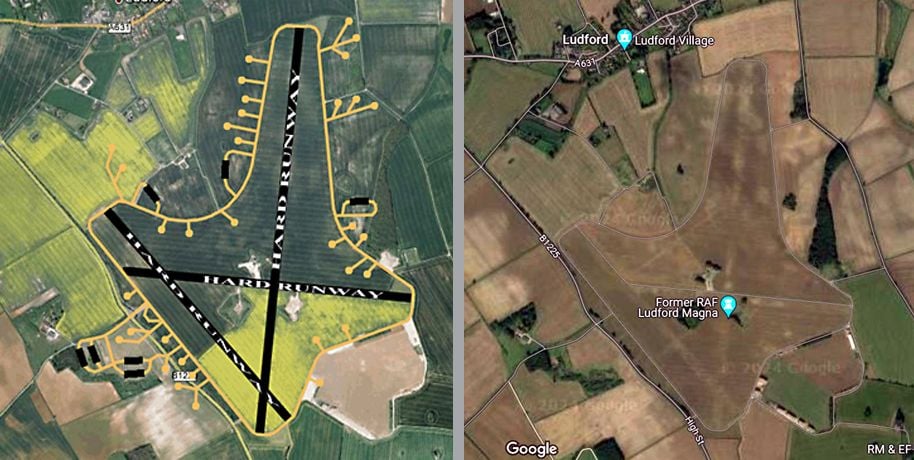
Little remains of the airfield from which Ron and his crew struggled to persuade their heavily laden Lancaster Nan Squared into the air. After the war Ludford was used as a Thor missile base, but once these became obsolete the runways and taxiways were lifted and like so many WW2 airfields, all that remains are the ghostly traces of the runways long after their removal, a few yards of crumbling concrete and the carefully tended 101 Sqn memorial in the nearby village.
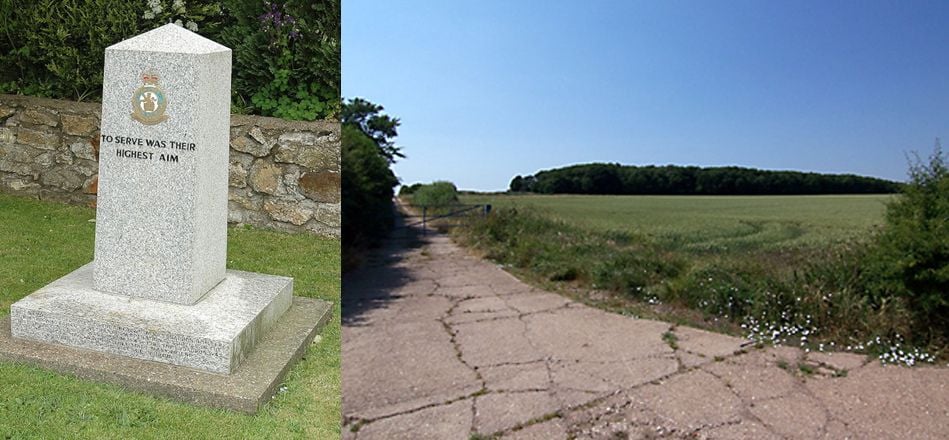
Last edited by Geriaviator; 21st Jan 2024 at 17:56. Reason: Addition of Youtube link
The following 7 users liked this post by Geriaviator:
Having just received my latest RAFHS Journal (#82), my thoughts turned to this thread as it features Bomber Command in 1943. Other Society Journals and Publications have also featured the Command, from its inception in 1936 to the Cold War. #82 is only available to current members, but all those up to #55 ( Coincidentally entitled "Bomber Command"! ), and associated Papers produced in co-operation with the RAF Staff College Bracknell, can be freely downloaded here :-
RAF Historical Society Journals (rafmuseum.org.uk)
Unlike more recent contributions these past talks were often delivered by those with personal experience of what they describe, and thus very much in keeping with the ethos of this revered thread. For the annual sub of £18 RAFHS membership is a bargain in my view, and open to all who are interested in the history of the RAF and the development of Air Power.
RAF Historical Society Journals (rafmuseum.org.uk)
Unlike more recent contributions these past talks were often delivered by those with personal experience of what they describe, and thus very much in keeping with the ethos of this revered thread. For the annual sub of £18 RAFHS membership is a bargain in my view, and open to all who are interested in the history of the RAF and the development of Air Power.
The following users liked this post:

By Pilot Officer Sam Brooks, London. Special Operator, 101 Sqn Royal Air Force.
THEY say you should never go back, nor seek to renew old acquaintances -- you will only be disappointed. I don't really believe it, but then a lot happens in a lifetime, and one is sometimes tempted not just to look ahead...
In the spring of 1943 I was called up and chose to join the RAF for training as aircrew. They said I could elect to be trained as a pilot and wait to join up for a year. Alternatively, they had vacancies for rear gunners -- come next Monday. I was keen to get started but... ummm. There was a third choice, be a wireless operator and come in three months. That sounded like a reasonable compromise, and I took it. August Bank holiday 1943 found me reporting to the ACRC (Air Crew Reception Centre), at Lordís cricket ground for induction and training.
I joined a squad of 30 likely lads, all destined to train as wireless operators, and we started initial training. Three weeks of inoculations and square bashing to commence. We lived in commandeered luxury flats along Prince Consort Road, marching to be fed in a similarly commandeered cafe at the zoo just across the road in Regents Park.
Then to Bridgnorth to 19 ITW (Initial Training Wing), where we started the rudiments of wireless training and began to absorb Morse code. November came and we moved to Number Two Radio School at Yatesbury in Wiltshire - a huge wooden-hutted camp in the middle of nowhere but with a small grass airfield next door, from which we would be taught wireless operating in the air.
The course we were embarked upon had been of two years duration before the war. Now it had been condensed into six months because of the enormous demand for aircrew in RAF Bomber Command. Enormous? Yes, the Bomber Command strength had built up to an ability to deliver 1,000-bomber raids over Germany on a nightly basis. Losses were significant, sometimes tragically large. They needed Aircrew.
We were all desperately keen and training classes went on from 8am to 6pm, six days a week - Sundays off. Phew! During this time I became friendly with another trainee in the group, Keith Gosling. I came from suburban London; Keith from Frizinghall, Bradford. We were very alike in character and background -- grammar school boys from stable homes, imbued with an ethic for hard work. Middle class, I suppose you would have had to call us. We had similar interests and abilities.
Did I say 'desperately keen'? It's worth repeating. We, and most of the other lads around us, were entirely and selflessly committed to becoming the best wireless operators ever! Neither Keith nor I had the slightest difficulty with the theoretical side of the course, but both found it extremely difficult to conquer the required speed barriers in Morse.
The course ended in the spring and we both passed with excellent marks. My mark on the theory side was 95%, and for operating in the air it was 85%. We proudly became sergeant wireless operators and stood by for posting to OTU (Operational Training Unit), the next stage towards operational flying.
During this time, waiting to be posted, two unusual things happened. First we were both asked to go before a commissioning board with a view to becoming officers. We were not told the results and suspected that we were not selected. The second strangeness came one morning on parade when the NCO in charge called on all those who had learned German at school to step forward. After a moment's hesitation, I did so. So did Keith with two others from the group.
Within a week we four were called in and told that the remainder of our training would be cut by some months as we would be posted to a familiarisation unit to get used to flying in heavy bombers. and we would probably be flying on operations within a month! Our job would be to fly in Lancasters to operate special jamming equipment designed to prevent the Luftwaffe night-fighter pilots from hearing directions from their ground controllers.
The following 8 users liked this post by Geriaviator:
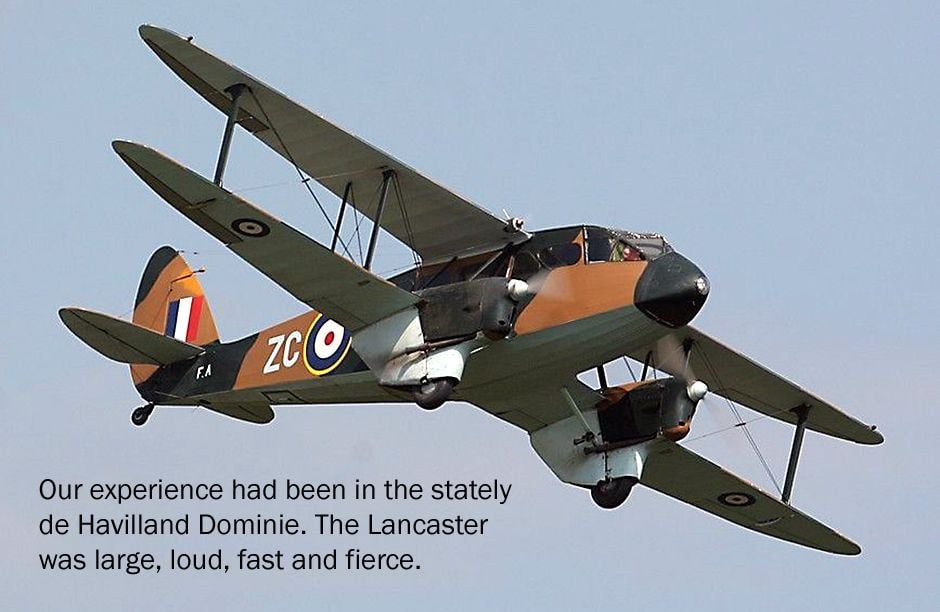
IT WAS a very exciting time. We were sent to No.1 LFS (Lancaster Finishing School) at Hemswell, north of Lincoln, to fly for 10 hours as passengers in Lancasters, and familiarise ourselves with being carried in large four-engined bombers. This was quite necessary as our air experience previously had been in the stately de Havilland Dominie (Dragon Rapide biplane) and tiny Percival Proctors. The Lancaster was large, loud, fast, and fierce. While we were there, the second front opened with D-Day on 6 June 1944.
Soon we went on to 101 Squadron at Ludford Magna on the Lincolnshire Wolds. This was a three-flight squadron, flying up to 24 Lancasters in the bomber stream, armed and loaded with bombs just like the other heavy bombers but with an extra crew member in each squadron aircraft to do the jamming.
Upon arrival the first thing was a few daysí introduction to the equipment we were to operate. It went under the codename 'ABC', which stood for Airborne Cigar; I have no idea why they named it that. It consisted of three enormous powerful transmitters covering the radio voice bands used by the Luftwaffe.
To help identify the channels to jam there was a panoramic receiver covering the same bands. The receiver scanned up and down the bands at high speed and the result of its travel was shown on a timebase calibrated across a three-inch cathode ray tube in front of the operator. If there was any traffic on the band it showed as a blip at the appropriate frequency along the line of light that was the timebase.
When a 'blip' appeared, one could immediately spot tune the receiver to it and listen to the transmission. If the language was German then it only took a moment to swing the first of the transmitters to the same frequency, press a switch and leave a powerful jamming warble there to prevent the underlying voice being heard. The other two transmitters could then be brought onto other 'blips'. If 24 aircraft were flying, spread through the bomber stream, then there were a potential 72 loud jamming transmissions blotting out the night fighters' directions.
The Germans tried all manner of devices to overcome the jamming, including having their instructions sung by Wagnerian sopranos. This was to fool our operators into thinking it was just a civilian channel and not worth jamming. I think ABC probably did a useful job, but who can say what difference it made. Anyway, it was an absorbing time for keen, fit, young men who thought only of the challenges and excitements of their task and little of the risks they were about to run.
Next step was to get "crewed up". The normal seven-man crews for Lancasters had been made up and had been flying together for months before arrival at the Squadron. We Special Duty Operators now had to tag on to established crews and it was left largely to us to find out with which pilot we, in our ignorance, might wish to fly.
Just before this process started both Keith and I were called into the squadron adjutant's office one morning and told that we had been commissioned as pilot officers. The adjutant, a kindly, ageing flight lieutenant, advised us to go to Louth, the local town, see a tailor and order an officer's uniform. We were to get the tailor to remove our sergeant's stripes and replace them with the narrow pilot officers shoulder bands on our battle-dresses. He should finally provide us with an officer's hat! The adjutant gave us vouchers to hand to the tailor to assure him he would be paid! We were told to move our kit from the NCOs' quarters to officers' accommodation and the adjutant would see us in the Officers' Mess at 6pm to buy us each a beer.
I had imagined that becoming an officer would include some kind of OTU or training course to instruct us what sort of behaviour might be expected of us. Not so, not for newly commissioned aircrew on a bomber station in Lincolnshire in the middle of 1944. What is described in the previous paragraph is all that happened.
Looking back I can see that all the things we were experiencing at this frenetic time were tremendous shocks to our systems. They left us ill equipped to take the apocalyptic decisions we were about to make and which, as it happened, would decide whether we lived or died.
The following 6 users liked this post by Geriaviator:
Join Date: Mar 2010
Location: Often in Jersey, but mainly in the past.
Age: 79
Posts: 7,811
Received 137 Likes
on
64 Posts
Like the instant Commissioning ... what a culture shock that would have been!
I have a copy of an Observer/Navigator/Bomb Aimer log book detailing Alan Dowden's time in 4 Group on Whitleys and Halifxes. It is full of one liners about the ops carried out. He went from being an LAC in 1941 to W/C OC 10 Sqn by the end of the war. The sqn was then converted to Dakotas and sent to India. I have often wondered how those ex Bomber Command crews must have felt about this. I think that I would have not been very happy having done my 'bit in Bomber Command.
My father's friend at Binbrook in 1949/50, Bob Nash from Vancouver, survived two tours on Lancasters, concerning which the nine-yr-old Geri pestered the life out of him. Despite all he loved flying and would drill me on an old Lanc used for dinghy drills. On hearing that we had returned from India in 1947 he told us he had sought a posting to India to fly Dakotas with a view to a career in civil aviation after the war but there were too many pilots chasing the few jobs. Instead a grateful nation allowed him to stay flying on Lincolns, at price of demotion from Flt Lt to Flt Sgt with appropriate lowering of pay and pensions.
By Pilot Officer Sam Brooks, London. Special operator, 101 Sqn Royal Air Force.
CREWING UP was to follow shortly, but on our first evening in the officers' mess we had met two Canadian pilots, Pilot Officers Daniel Meier and Gordon Hodgkinson, newly arrived on the squadron with their crews and eager to find their extra ABC wireless operators. Our decisions were made that night. I got on well with both of them, but perhaps had marginally more in common with Gordon Hodgkinson than Meier. Keith felt perhaps closer to Meier and so our choices were made, almost by the toss of a coin: me for Hodgkinson, Keith for Meier.
I started flying with Hodgkinson who, as it happened, did not find it easy to settle down to the conditions over a hostile Germany. Our first operational flight was on 30 June 1944. 'Hodge' managed seven operations, but remained unsettled and had turned back unwell on two occasions. He was finally taken off flying and went back to Canada. I was re-crewed with a succession of other crews and completed my tour of 30 operations on 6 January 1945.
Keith started flying with Meier about the same time as I started. Our other two sergeant colleagues from Yatesbury also joined crews of their choice. One of them, Englehardt, died I believe in a raid on Stettin in August and was buried where his aircraft crashed in Sweden on the way home. The fourth of us, Auer, survived like me.
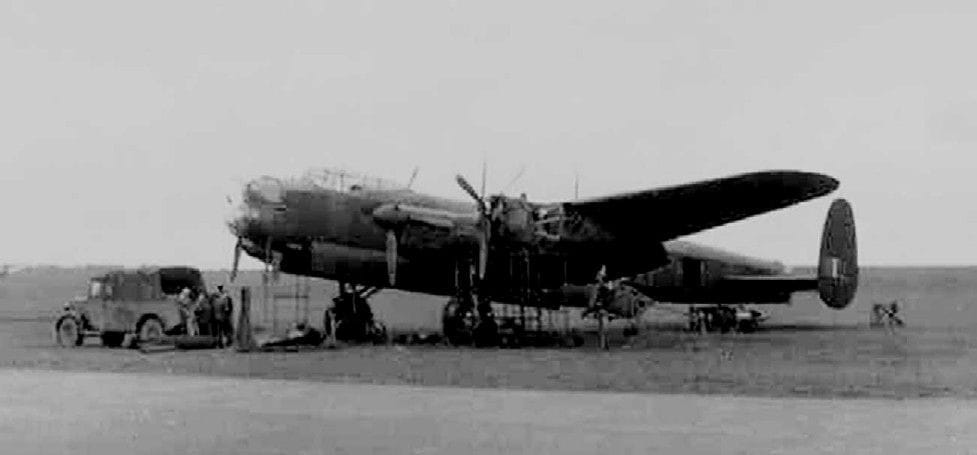
Like most Bomber Command airfields, aircraft were serviced at dispersals in all weathers. Despite the howling gales across the Lincolnshire Wolds, and the highest airfield in Britain, a team of unsung groundcrew service a 101 Sqn Lancaster with its triple ABC aerials. Note the sea of mud around the concrete standing Ė they had good reason to retitle their base as RAF Mudford Magna.
When we were flying on raids to the industrial Ruhr the route for the bomber stream was often from base to Reading; Reading to Beachy Head; Beachy Head to Le Treport; then east across France and into Germany. This was our route to attack the Homberg/Meerbeck oil refinery in the Ruhr on the night of 20 July, 1944
Meier's Lancaster did not return and the crew were posted as missing. We learned later that they were homebound when they were hit by Flak at 8000 feet north of Lille, crashing a little to the south of Cambrai. It was less than a year since Keith and I had joined up on August Bank Holiday in 1943 at Lordís Cricket Ground.
Keith's mother Florence knew that we had been friends and wrote to me. There was little I could do to help or advise her as to what had happened. For a while I hoped that we would hear that Keith had been taken prisoner but it was not to be.
It was some months before I heard the story of the crew's fate that night, and strangely enough it came from Florence. The flak had caused Meier's Lancaster LL862 K for King to lose a wing and break up. By the best of good fortune two members of the crew had parachuted down into occupied France. The other six, including my pal Keith, did not escape.
All this information was vouchsafed to Florence in a letter from one of the survivors who had felt obliged to write to the relatives of each member of the crew when he was released from a POW camp. Florence had wrongly thought that it was Meier the pilot who had survived and she could not understand how the captain of the aircraft could have survived when six of his crew had died. She quoted the naval tradition that a captain should be the last to leave his sinking ship.
I had seen our bombers shot down in daylight raids, and knew that once an aircraft began to break up there was absolutely nothing that anyone could do except try to save himself. I tried as gently as I could to get this across to Florence. We continued to exchange letters but our correspondence petered out in mid-1945 when the German war was over and I was posted to India to prepare for the attack on Japan.
Of course the bomb in August made that unnecessary and I spent two years in various parts of the Far East, waiting to be demobilised. When I came home again I never forgot my friendship with Keith, but I did not feel inclined to re-open an old wound for Florence by trying to get in touch again. Maybe I should have done so, but I didn't.
CREWING UP was to follow shortly, but on our first evening in the officers' mess we had met two Canadian pilots, Pilot Officers Daniel Meier and Gordon Hodgkinson, newly arrived on the squadron with their crews and eager to find their extra ABC wireless operators. Our decisions were made that night. I got on well with both of them, but perhaps had marginally more in common with Gordon Hodgkinson than Meier. Keith felt perhaps closer to Meier and so our choices were made, almost by the toss of a coin: me for Hodgkinson, Keith for Meier.
I started flying with Hodgkinson who, as it happened, did not find it easy to settle down to the conditions over a hostile Germany. Our first operational flight was on 30 June 1944. 'Hodge' managed seven operations, but remained unsettled and had turned back unwell on two occasions. He was finally taken off flying and went back to Canada. I was re-crewed with a succession of other crews and completed my tour of 30 operations on 6 January 1945.
Keith started flying with Meier about the same time as I started. Our other two sergeant colleagues from Yatesbury also joined crews of their choice. One of them, Englehardt, died I believe in a raid on Stettin in August and was buried where his aircraft crashed in Sweden on the way home. The fourth of us, Auer, survived like me.

Like most Bomber Command airfields, aircraft were serviced at dispersals in all weathers. Despite the howling gales across the Lincolnshire Wolds, and the highest airfield in Britain, a team of unsung groundcrew service a 101 Sqn Lancaster with its triple ABC aerials. Note the sea of mud around the concrete standing Ė they had good reason to retitle their base as RAF Mudford Magna.
When we were flying on raids to the industrial Ruhr the route for the bomber stream was often from base to Reading; Reading to Beachy Head; Beachy Head to Le Treport; then east across France and into Germany. This was our route to attack the Homberg/Meerbeck oil refinery in the Ruhr on the night of 20 July, 1944
Meier's Lancaster did not return and the crew were posted as missing. We learned later that they were homebound when they were hit by Flak at 8000 feet north of Lille, crashing a little to the south of Cambrai. It was less than a year since Keith and I had joined up on August Bank Holiday in 1943 at Lordís Cricket Ground.
Keith's mother Florence knew that we had been friends and wrote to me. There was little I could do to help or advise her as to what had happened. For a while I hoped that we would hear that Keith had been taken prisoner but it was not to be.
It was some months before I heard the story of the crew's fate that night, and strangely enough it came from Florence. The flak had caused Meier's Lancaster LL862 K for King to lose a wing and break up. By the best of good fortune two members of the crew had parachuted down into occupied France. The other six, including my pal Keith, did not escape.
All this information was vouchsafed to Florence in a letter from one of the survivors who had felt obliged to write to the relatives of each member of the crew when he was released from a POW camp. Florence had wrongly thought that it was Meier the pilot who had survived and she could not understand how the captain of the aircraft could have survived when six of his crew had died. She quoted the naval tradition that a captain should be the last to leave his sinking ship.
I had seen our bombers shot down in daylight raids, and knew that once an aircraft began to break up there was absolutely nothing that anyone could do except try to save himself. I tried as gently as I could to get this across to Florence. We continued to exchange letters but our correspondence petered out in mid-1945 when the German war was over and I was posted to India to prepare for the attack on Japan.
Of course the bomb in August made that unnecessary and I spent two years in various parts of the Far East, waiting to be demobilised. When I came home again I never forgot my friendship with Keith, but I did not feel inclined to re-open an old wound for Florence by trying to get in touch again. Maybe I should have done so, but I didn't.
The following 5 users liked this post by Geriaviator:
The following users liked this post:
Ludford Magna was nowhere near the highest airfield in Britain. It was the highest bomber airfield, according to wiki, at 428 feet above sea level but Davidstow Moor Coastal Command airfield in Cornwall was well over twice the altitude at 965 feet.
Ooooh dear. Thank goodness for Wiki to keep me right.
Sarcasm doesn't become you.
I had no idea of the altitude of Ludford Magna but I knew that Davidstow Moor was the highest airfield in Britain.
I was also amazed to find that somewhere in Lincolnshire was over 400' above sea level.
I had no idea of the altitude of Ludford Magna but I knew that Davidstow Moor was the highest airfield in Britain.
I was also amazed to find that somewhere in Lincolnshire was over 400' above sea level.
Nearby Kelstern (054/4nm) is around 410 feet. Binbrook is pretty high up, I'm sure someone here will remember it's elevation.
The following users liked this post:
According to Military Airfields in the British Isles 1939-45 (Omnibus Edition) by Willis and Holliss, Ludford Magna is 420', Kelstern is 410' and Binbrook 330' asl. Davidstow Moor is 969' asl.
The data is apparently based on official documentation so should be reliable. 969' seems peculiarly precise...
The data is apparently based on official documentation so should be reliable. 969' seems peculiarly precise...
The following users liked this post:



